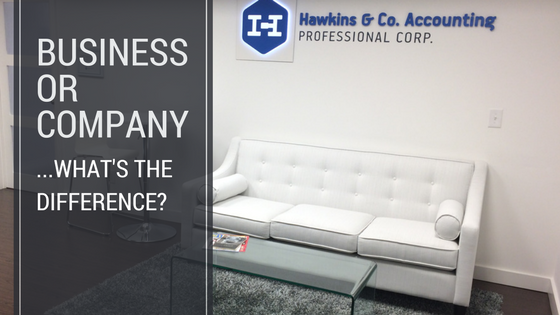In good company (Abridged)
As you know, we work with a lot of start-ups and new businesses. This is a topic which causes some confusion. So time for another public-service blog to clear it up… There’s a lot more to this, but here are the highlights.
A lot of people use the term “business” and “company” interchangeably. This is a mistake. The two are very distinct. Here’s the condensed explanation:
A business is a set of activities you carry out (eg. make and sell widgets), with a view to making profit.
A company is a legal entity that has been created (“incorporated”) for a specific purpose. It has the legal right to enter into transactions, to buy and sell assets – and also to take on debts and be responsible for paying taxes on any profits it makes. A company is typically set up to house a business. Hence the confusion.
So… You’re a business owner. You basically have 3 choices of how you structure your business. This is how it is in Canada – US concepts such as LLCs or C-corps don’t apply here.
At its simplest, you can run your business as a proprietorship. This basically means that – in both law and tax – the business is indistinguishable from you. This means that:
- You own the assets. If you have bought equipment or supplies for the business, they belong to you, personally. If the business has money in its bank account, that’s yours too.
- You’re on the hook for the liabilities. If you buy stuff on credit for the business, take out a loan, or somebody sues the business, that’s your liability. There’s no limit on this – right up to personal bankruptcy.
- The revenues and expenses of the business are yours. If there are profits, then you declare them on your tax return – and have to pay taxes on them.
You could also structure your business as a partnership. This is basically much the same as a proprietorship, but with more people, who are sharing the profit. The biggest differences:
- You need to have an arrangement on how the partners will run the business. Who does what, puts money in, how you split the profit, what happens if one of you wants out, etc.
- Everybody is potentially on the hook for all the liabilities. It’s not 50/50. If the business goes bust owing $1m and Partner A’s has no assets, then creditors can come after Partner B for the full amount. Choose your partners wisely!
As enterprise started to grow, this became a constraint. Successful entrepreneurs – who had accumulated significant personal wealth – wanted to band together to create infrastructure like roads, canals and railways that would support them. [Context: this is 18th century UK] But… the risk and amounts involved were such that they didn’t want to put all their assets at risk for it.
So this lead to the creation of the joint-stock corporation (or “company”, because it was a company of entrepreneurs working together). This was a revolutionary idea, and at first each new company needed a specific Act of Parliament, until eventually the lawmakers passed a law laying out how you would create a company in future. Here’s how it works:
- An entrepreneur puts money into the corporation in exchange for the rights to a share of the profits created by the business carried out by the corporation. The right to that share can be purchased or sold by the shareholder, either by private agreement or on a stock exchange.
- The corporation uses that money to set up and then run the business. So the assets, liabilities, revenues and expenses of the business reside in the corporation. The corporation pays tax on any profits. Any remaining profits can be distributed to the shareholders as a dividend.
- The shareholder’s liability was limited to what he put in (yes, it was all men back then). No risk to personal assets other than what he’d put in.
- The shareholders couldn’t all be involved in running the business, so they would elect directors who would oversee the activities of the company on behalf of the shareholders.
- The directors may not actually run the business, but would hire management and employees who would.
This was so successful that pretty well every big business today is structured this way. If you have any mutual funds or other equity funds in your RRSP, you’re (indirectly) a shareholder. Congratulations.
Fascinating. So what?
Well, if you’re starting out, you still have this choice of how to structure your business. The facts described above haven’t changed much in the last 200 years.
People often start as proprietors or partners, and then at some stage move their business into a corporation which they own. But for some people, the benefits of doing this will never outweigh the costs – and a proprietorship remains just fine for them. I often see people who’ve been urged to incorporate, which really wasn’t the right set-up.
Bear in mind that your business structure won’t make any difference to how you actually run your business. If you make and sell widgets, you’ll still make and sell widgets.
Here is a brief list of reasons why you might want to incorporate your business – either at the start, or later. Again, not comprehensive:
Customers or market requires it
In a few cases, government businesses (including utilities etc.) are limited to dealing with corporations. So, if you’re an IT consultant working for Union Gas, you have to set up a company.
In other cases, you just sound more credible if you’re incorporated. Would you rather buy your new residence from Hawkins Homebuilding Corporation, or me personally, trading as “Jules’ Happy Homes”?
Risk profile and tolerance
This depends on how risky your business is, what personal assets you have at stake, and how you feel about that.
Some businesses – eg. consulting – are not particularly risky, and so there’s never really any risk to your personal assets. Others are inherently more risky. For this reason, I normally encourage restauranteurs and truck drivers to consider incorporating. If they screw up badly enough, they could kill somebody.
This may also evolve. You start out fresh out of school with a small business and few assets. After 20 years, it’s much bigger – so the numbers are larger – and you’ve got some personal wealth you’d like to protect. Time to incorporate.
You want to bring others in, or sell out.
It’s a lot easier to change ownership in a corporation than in a proprietorship. Including partial changes.
Tax reasons
This gets technical. Call if it excites you. But…. in summary, a corporation can bring flexibility in the timing of when you pay taxes, and in principal give you the opportunity to save taxes in absolute terms.
This is currently in flux – the federal government proposed significant changes to tax law in July 2017, which will reduce the potential tax savings, thereby removing an “artificial” incentive to incorporate. I’ll blog about that later.
BUT there are circumstances when it’s definitely worth considering, for tax reasons. Again, techie stuff, but for example:
- The business will be taking on debt, which you will repay out of cash generated by the business.
- You expect to sell all or part of the business soon, at a significant gain.
Reasons not to?
Well, there’s always good “Too busy making money”, “Other stuff to do”, or “Can’t be bothered”. All valid reasons, in their time and place.
You should also be aware of the following:
- If you expect losses in the first years of your business, you can offset those against income from (for example) a different job, and get a tax refund. You can only do this if you’re operating as a proprietorship. You can’t if you incorporate your business from day 1.
- Extra complexity. Basically, if you’ve incorporated, you’re now thinking about two legal entities (you and your corporation) and how they interact. I have some clients who I will not incorporate – they just can’t get their arms around the details of how it would work. They need to.
- Extra cost. There’s cost involved in setting up the corporation (particularly if you’re transferring over an existing business), and then extra ongoing cost. These will depend on what you do, but don’t be surprised if it’s $3-4k to set up, and then $2-3k a year thereafter. Tax savings may justify that, but not guaranteed. So it’s a valid financial decision as to whether it’s worth it.
Enjoy! And call if you have questions.

